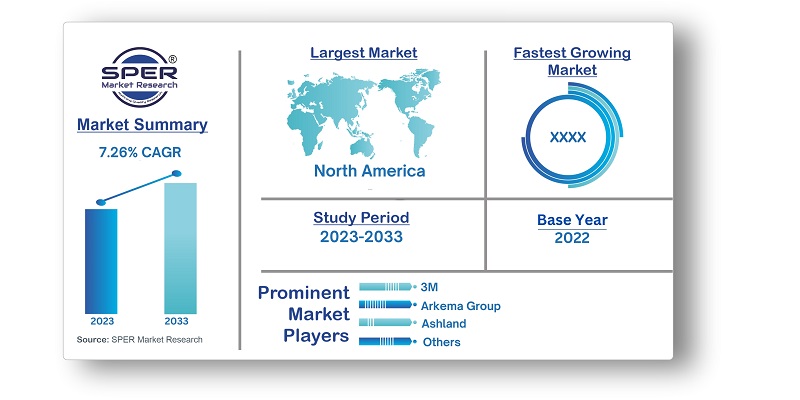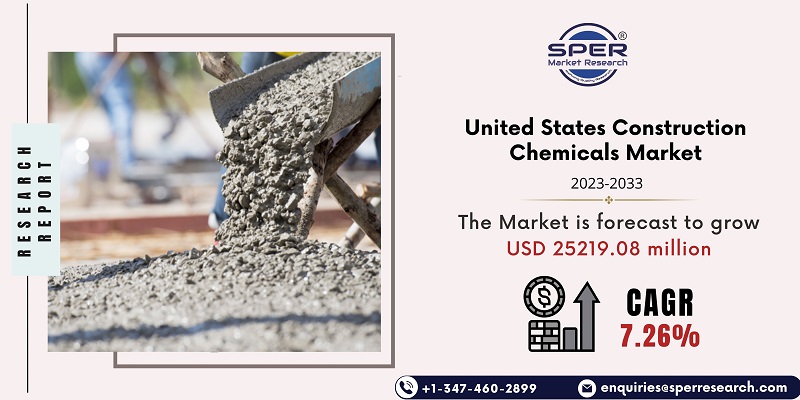
United States Construction Chemicals Market Growth, Size, Trends, Revenue and Future Outlook
United States Construction Chemicals Market Size- By Product Type, By End User- Regional Outlook, Competitive Strategies and Segment Forecast to 2033
| Published: Feb-2024 | Report ID: CHEM2414 | Pages: 1 - 103 | Formats*: |
| Category : Chemical & Materials | |||
- The acquisition of Brett Admixtures, a company that produces liquid concrete admixtures and mainly supplies the upper Midwest of the United States, was announced in November 2020 by Euclid Chemical, a division of RPM International Inc.
- CHRYSO and Solidia worked together in September 2020 to implement ultra-low CO2 concrete. Using their combined chemical expertise, the two companies worked together to enhance Solidia ultra-low CO2 concrete's material properties and sustainability performance.


| Report Metric | Details |
| Market size available for years | 2019-2033 |
| Base year considered | 2022 |
| Forecast period | 2023-2033 |
| Segments covered | By Product Type, By End User |
| Regions covered | Eastern Region, Western Region, Southern Region, Northern Region |
| Companies Covered | 3M, Arkema Group, Ashland, Chryso SAS, Dow, DuPont, Franklin International, Inc., GCP Applied Technologies, Holcim, Krete Industries Inc., MAPEI SpA, MBCC Group, Pidilite Industries Ltd, RPM International Inc., Sika AG, Others |
- Construction Companies and Contractors
- Architects and Designers
- Builders and Contractors
- Building Owners and Developers
- Manufacturers and Suppliers
| By Product Type: |
|
| By End User: |
|
- United States Construction Chemicals Market Size (FY’2023-FY’2033)
- Overview of United States Construction Chemicals Market
- Segmentation of United States Construction Chemicals Market By Product Type (Concrete Admixture and Cement Grinding Aids, Surface Treatment, Repair and Rehabilitations, Protective Coatings, Industrial Flooring, Waterproofing Solutions, Adhesive and Sealants, Grouts and Anchors)
- Segmentation of United States Construction Chemicals Market By End User (Commercial, Industrial, Infrastructure, Residential, Others)
- Expansion Analysis of United States Construction Chemicals Market
- Problems and Obstacles in United States Construction Chemicals Market
- Competitive Landscape in the United States Construction Chemicals Market
- Impact of COVID-19 and Demonetization on United States Construction Chemicals Market
- Details on Current Investment in United States Construction Chemicals Market
- Competitive Analysis of United States Construction Chemicals Market
- Prominent Players in the United States Construction Chemicals Market
- SWOT Analysis of United States Construction Chemicals Market
- United States Construction Chemicals Market Future Outlook and Projections (FY’2023-FY’2033)
- Recommendations from Analyst
1.1. Scope of the report1.2. Market segment analysis
2.1. Research data source2.1.1. Secondary Data2.1.2. Primary Data2.1.3. SPER’s internal database2.1.4. Premium insight from KOL’s2.2. Market size estimation2.2.1. Top-down and Bottom-up approach2.3. Data triangulation
4.1. Driver, Restraint, Opportunity and Challenges analysis4.1.1. Drivers4.1.2. Restraints4.1.3. Opportunities4.1.4. Challenges4.2. COVID-19 Impacts of the United States Construction Chemicals Market
5.1. SWOT Analysis5.1.1. Strengths5.1.2. Weaknesses5.1.3. Opportunities5.1.4. Threats5.2. PESTEL Analysis5.2.1. Political Landscape5.2.2. Economic Landscape5.2.3. Social Landscape5.2.4. Technological Landscape5.2.5. Environmental Landscape5.2.6. Legal Landscape5.3. PORTER’s Five Forces5.3.1. Bargaining power of suppliers5.3.2. Bargaining power of buyers5.3.3. Threat of Substitute5.3.4. Threat of new entrant5.3.5. Competitive rivalry5.4. Heat Map Analysis
6.1. United States Construction Chemicals Market Manufacturing Base Distribution, Sales Area, Product Type6.2. Mergers & Acquisitions, Partnerships, Product Launch, and Collaboration in United States Construction Chemicals Market
7.1. United States Construction Chemicals Market Value Share and Forecast, By Product Type, 2023-20337.2. Concrete Admixture and Cement Grinding Aids7.3. Surface Treatment7.4. Repair and Rehabilitations7.5. Protective Coatings7.6. Industrial Flooring7.7. Waterproofing Solutions7.8. Adhesive and Sealants7.9. Grouts and Anchors
8.1. United States Construction Chemicals Market Value Share and Forecast, By End User, 2023-20338.2. Commercial8.3. Industrial8.4. Infrastructure8.5. Residential8.6. Others
9.1. United States Construction Chemicals Market Size and Market Share
10.1. United States Construction Chemicals Market Size and Market Share By Product Type (2019-2026)10.2. United States Construction Chemicals Market Size and Market Share By Product Type (2027-2033)
11.1. United States Construction Chemicals Market Size and Market Share By End User (2019-2026)11.2. United States Construction Chemicals Market Size and Market Share By End User (2027-2033)
12.1. United States Construction Chemicals Market Size and Market Share By Region (2019-2026)12.2. United States Construction Chemicals Market Size and Market Share By Region (2027-2033)12.3. Eastern Region12.4. Western Region12.5. Southern Region12.6. Northern Region
13.1. 3M13.1.1. Company details13.1.2. Financial outlook13.1.3. Product summary13.1.4. Recent developments13.2. Arkema Group13.2.1. Company details13.2.2. Financial outlook13.2.3. Product summary13.2.4. Recent developments13.3. Ashland13.3.1. Company details13.3.2. Financial outlook13.3.3. Product summary13.3.4. Recent developments13.4. Chryso SAS13.4.1. Company details13.4.2. Financial outlook13.4.3. Product summary13.4.4. Recent developments13.5. Dow13.5.1. Company details13.5.2. Financial outlook13.5.3. Product summary13.5.4. Recent developments13.6. DuPont13.6.1. Company details13.6.2. Financial outlook13.6.3. Product summary13.6.4. Recent developments13.7. Franklin International, Inc.13.7.1. Company details13.7.2. Financial outlook13.7.3. Product summary13.7.4. Recent developments13.8. GCP Applied Technologies13.8.1. Company details13.8.2. Financial outlook13.8.3. Product summary13.8.4. Recent developments13.9. Holcim13.9.1. Company details13.9.2. Financial outlook13.9.3. Product summary13.9.4. Recent developments13.10. Krete Industries Inc.13.10.1. Company details13.10.2. Financial outlook13.10.3. Product summary13.10.4. Recent developments13.11. MAPEI SpA13.11.1. Company details13.11.2. Financial outlook13.11.3. Product summary13.11.4. Recent developments13.12. MBCC Group13.12.1. Company details13.12.2. Financial outlook13.12.3. Product summary13.12.4. Recent developments13.13. Pidilite Industries Ltd13.13.1. Company details13.13.2. Financial outlook13.13.3. Product summary13.13.4. Recent developments13.14. RPM International Inc.13.14.1. Company details13.14.2. Financial outlook13.14.3. Product summary13.14.4. Recent developments13.15. Sika AG13.15.1. Company details13.15.2. Financial outlook13.15.3. Product summary13.15.4. Recent developments13.16. Others
SPER Market Research’s methodology uses great emphasis on primary research to ensure that the market intelligence insights are up to date, reliable and accurate. Primary interviews are done with players involved in each phase of a supply chain to analyze the market forecasting. The secondary research method is used to help you fully understand how the future markets and the spending patterns look likes.
The report is based on in-depth qualitative and quantitative analysis of the Product Market. The quantitative analysis involves the application of various projection and sampling techniques. The qualitative analysis involves primary interviews, surveys, and vendor briefings. The data gathered as a result of these processes are validated through experts opinion. Our research methodology entails an ideal mixture of primary and secondary initiatives.



Frequently Asked Questions About This Report
PLACE AN ORDER
Year End Discount
Sample Report
Pre-Purchase Inquiry
NEED CUSTOMIZATION?
Request CustomizationCALL OR EMAIL US
100% Secure Payment






Related Reports
Our Global Clients
Our data-driven insights have influenced the strategy of 200+ reputed companies across the globe.




















